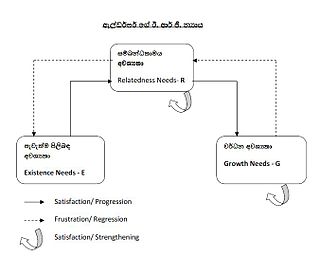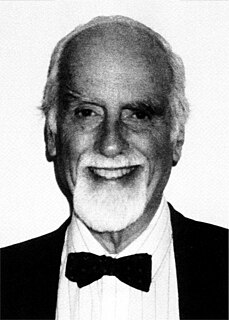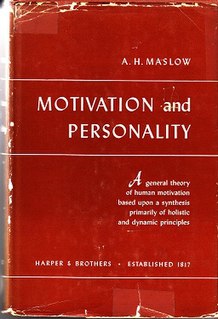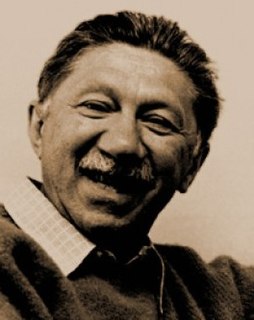The Human Potential Movement (HPM) arose out of the counterculture milieu of the 1960s and formed around the concept of cultivating extraordinary potential that its advocates believe to lie largely untapped in all people. The movement took as its premise the belief that through the development of "human potential", humans can experience an exceptional quality of life filled with happiness, creativity, and fulfillment. As a corollary, those who begin to unleash this assumed potential often find themselves directing their actions within society towards assisting others to release their potential. Adherents believe that the net effect of individuals cultivating their potential will bring about positive social change at large.
Motivation is the reason for people's actions, willingness and goals. Motivation is derived from the word motive in the English language which is defined as a need that requires satisfaction. These needs could also be wants or desires that are acquired through influence of culture, society, lifestyle, etc. or generally innate. Motivation is one's direction to behaviour, or what causes a person to want to repeat a behaviour, a set of force that acts behind the motives. An individual's motivation may be inspired by others or events or it may come from within the individual. Motivation has been considered as one of the most important reasons that inspires a person to move forward in life. Motivation results from the interaction of both conscious and unconscious factors. Mastering motivation to allow sustained and deliberate practice is central to high levels of achievement e.g. in the worlds of elite sport, medicine or music.
Humanistic psychology is a psychological perspective that rose to prominence in the mid-20th century in answer to the limitations of Sigmund Freud's psychoanalytic theory and B. F. Skinner's behaviorism. With its roots running from Socrates through the Renaissance, this approach emphasizes individuals' inherent drive towards self-actualization, the process of realizing and expressing one's own capabilities and creativity.
A need is something that is necessary for an organism to live a healthy life. Needs are distinguished from wants in that, in the case of a need, a deficiency causes a clear adverse outcome: a dysfunction or death. In other words, a need is something required for a safe, stable and healthy life while a want is a desire, wish or aspiration. When needs or wants are backed by purchasing power, they have the potential to become economic demands.

Theory X and Theory Y are theories of human work motivation and management. They were created by Douglas McGregor while he was working at the MIT Sloan School of Management in the 1950s, and developed further in the 1960s. McGregor's work was rooted in motivation theory alongside the works of Abraham Maslow, who created the hierarchy of needs. The two theories proposed by McGregor describe contrasting models of workforce motivation applied by managers in human resource management, organizational behavior, organizational communication and organizational development. Theory X explains the importance of heightened supervision, external rewards, and penalties, while Theory Y highlights the motivating role of job satisfaction and encourages workers to approach tasks without direct supervision. Management use of Theory X and Theory Y can affect employee motivation and productivity in different ways, and managers may choose to implement strategies from both theories into their practices.
Content theory explains why human needs change with time. Content theory includes the work of David McClelland, Abraham Maslow and other psychologists as they attempted to explain why human needs change, but not how they change. They explain the specific factors that motivate behavior. None of these theories have been conclusively shown to be valid but they are helpful in providing a contextual framework for dealing with individuals.

ERG theory is a theory in psychology proposed by Clayton Alderfer.
Theory Z is a name for various theories of human motivation built on Douglas McGregor's Theory X and Theory Y. Theories X, Y and various versions of Z have been used in human resource management, organizational behavior, organizational communication and organizational development.
A peak experience is a moment accompanied by a euphoric mental state often achieved by self-actualizing individuals. The concept was originally developed by Abraham Maslow in 1964, who describes peak experiences as "rare, exciting, oceanic, deeply moving, exhilarating, elevating experiences that generate an advanced form of perceiving reality, and are even mystic and magical in their effect upon the experimenter." There are several unique characteristics of a peak experience, but each element is perceived together in a holistic manner that creates the moment of reaching one's full potential. Peak experiences can range from simple activities to intense events; however, it is not necessarily about what the activity is, but the ecstatic, blissful feeling that is being experienced during it.
Dependency need is "the vital, originally infantile needs for mothering, love, affection, shelter, protection, security, food, and warmth." A dependency need is thought to be characterized by two components: (1) It is a real need of an organism, something that must be present in order for the organism to be able to thrive, (2) It is something that an individual cannot provide for him or herself. It is well known that infants have many dependency needs; some of these needs are obvious, others have only come to the attention of researchers as the result of epidemiological studies. The more obvious needs of infants include: adequate feeding, adequate watering, adequate cleaning, adequate shelter, and more specifically, keeping the infant's body temperature within the narrow range of normalcy. On the other hand, it was not well known until the middle of the 20th century that infants also required the presence of warmth and affection, known as "maternal warmth". The greatest number of dependency needs seem to be encompassed in infancy, however, dependency needs begin to change and decrease with age and maturity. This marked decrease in dependency needs as an individual gets older can be largely attributed to the notion that, as an individual gets older, he or she becomes capable of providing these things for him or herself. However, to some extent, these needs remain present even into adulthood. Even as adults, people have certain universal dependency needs that remain constant throughout the lifespan that they are not able to provide for themselves; these include: the need to belong, need for affection, as well as the need for emotional support. These needs can usually be met by partnership, in which both partners get used to depending on one another. If adults lack partnership, their needs can usually be met by family and/or friend relationships.
Personal development covers activities that improve awareness and identity, develop talents and potential, build human capital and facilitate employability, enhance the quality of life and contribute to the realization of dreams and aspirations. Personal development takes place over the course of a person's entire life. Not limited to self-help, the concept involves formal and informal activities for developing others in roles such as teacher, guide, counselor, manager, life coach or mentor. When personal development takes place in the context of institutions, it refers to the methods, programs, tools, techniques, and assessment systems that support human development at the individual level in organizations.
Religious views on the self vary widely. The self is a complex and core subject in many forms of spirituality. In Western psychology, the concept of self comes from Sigmund Freud, Carl Jung, and Carl Rogers where the self is the inner critic. Two types of self are commonly considered - the self that is the ego, also called the learned, superficial self of mind and body, "false self", an egoic creation, and the Self which is sometimes called the "true self", the "Observing Self", or the "Witness".

David Clarence McClelland was an American psychologist, noted for his work on motivation Need Theory. He published a number of works between the 1950s and the 1990s and developed new scoring systems for the Thematic Apperception Test (TAT) and its descendants. McClelland is credited with developing Achievement Motivation Theory, commonly referred to as "need for achievement" or n-achievement theory. A Review of General Psychology survey published in 2002, ranked McClelland as the 15th most cited psychologist of the 20th century.

The Jonah complex is the fear of success or the fear of being one's best which prevents self-actualization, or the realization of one's own potential. It is the fear of one's own greatness, the evasion of one's destiny, or the avoidance of exercising one's talents. As the fear of achieving a personal worst may serve to motivate personal growth, likewise the fear of achieving a personal best may hinder achievement.
Work motivation "is a set of energetic forces that originate both within as well as beyond an individual's being, to initiate work-related behavior, and to determine its form, direction, intensity, and duration" Understanding what motivates an organization's employees is central to the study of I–O psychology. Motivation is a person's internal disposition to be concerned with and approach positive incentives and avoid negative incentives. To further this, an incentive is the anticipated reward or aversive event available in the environment. While motivation can often be used as a tool to help predict behavior, it varies greatly among individuals and must often be combined with ability and environmental factors to actually influence behavior and performance. Results from a 2012 study, which examined age-related differences in work motivation, suggest a "shift in people's motives" rather than a general decline in motivation with age. That is, it seemed that older employees were less motivated by extrinsically related features of a job, but more by intrinsically rewarding job features. Work motivation is strongly influenced by certain cultural characteristics. Between countries with comparable levels of economic development, collectivist countries tend to have higher levels of work motivation than do countries that tend toward individualism. Similarly measured, higher levels of work motivation can be found in countries that exhibit a long versus a short-term orientation. Also, while national income is not itself a strong predictor of work motivation, indicators that describe a nation’s economic strength and stability, such as life expectancy, are. Work motivation decreases as a nation’s long term economic strength increases. Currently work motivation research has explored motivation that may not be consciously driven. This method goal setting is referred to as goal priming. Effects of primed subconscious goals in addition to goals that are consciously set related to job performance have been studied by Stajkovic, Latham, Sergent, and Peterson, who conducted research on a CEO of a for-profit business organization using goal priming to motivate job performance. Goal priming refers to the achievement of a goal by external cues given. These cues can affect information processing and behaviour the pursuit of this goal. In this study, the goal was primed by the CEO using achievement related words strategy placed in emails to employees. This seemingly small gesture alone not only cost the CEO very little money, but it increased objectively measured performance efficiency by 35% and effectiveness by 15% over the course of a 5 day work week. There has been controversy about the true efficacy of this work as to date, only four goal priming experiments have been conducted. However, the results of these studies found support for the hypothesis that primed goals do enhance performance in a for-profit business organization setting.

Maslow on Management is a work on industrial psychology by Abraham Maslow, first published in 1965. Maslow's work is frequently invoked in attempts to explain and predict work behavior. In his work Maslow advocated the eupsychian management as the ideal model for industrial organizations. Maslow took a keen interest in the application of humanistic psychology beyond one-on-one therapy to larger endeavors in organizations and education settings, where greater numbers of people could be positively affected.

Motivation and Personality is a book on psychology by Abraham Maslow, first published in 1954. Maslow's work deals with the subject of the nature of human fulfillment and the significance of personal relationships, implementing a conceptualization of self-actualization. Underachievers have a need for social love and affection, but a self-actualized person has these "lower" needs gratified and is able to pursue his or her own path towards self-actualization.







